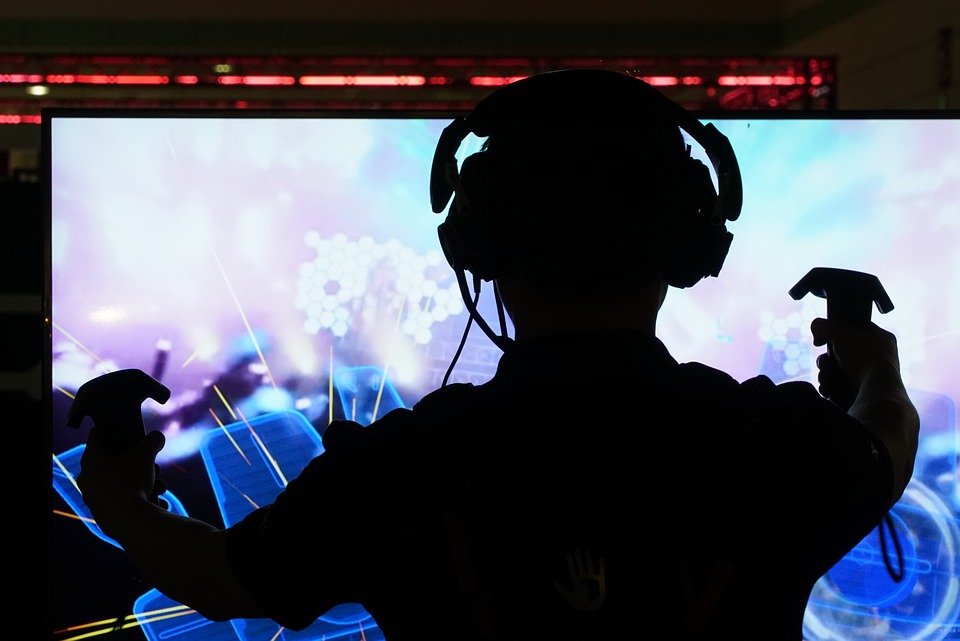Virtual reality is a system that immerses the user in an artificial, three-dimensional environment where they are free to explore and interact in any way they choose.
Table of Contents
What is Virtual Reality in Simple Words?

Virtual reality is created through a computer interface in which the computer sends electrical impulses to the user’s brain in response to what they are seeing, hearing, or feeling.
You can experience virtual reality by putting on a headset that contains two screens in front of your eyes, one for each eye. The combination of these screens creates an image that looks very realistic; it feels like you are actually there!
Examples of Virtual Reality?
Virtual Reality is a fascinating technology that has been gaining a lot of popularity recently. Here are some examples of virtual reality:
- Heading home from work, you put on your virtual reality headset and transport yourself to the beach for the next hour instead.
- While standing in line at the grocery store, you slip on your virtual reality goggles and are instantly transported to the top of a snow-capped mountain.
- You’re at home on a boring Sunday evening, so you put on your virtual reality headset and go on an adventure in a far-off land.
As you can see, there are endless possibilities for experiencing virtual reality. It is truly an incredible technology that can be used for entertainment, education, or work purposes. I highly recommend giving it a try!
Is Virtual Reality Real?
Virtual reality can be real or imagined, but it is usually experienced through a computer program that creates an artificial environment. The artificial environment created by virtual reality is often referred to as an ersatz world because it does not exist outside of the computer program itself.
Although virtual reality can imitate physical experiences, its main goal is usually to create something entirely new. For example, video games are considered virtual realities because they are completely imaginary worlds created through code on a computer screen.
There are many benefits of using virtual reality aside from entertainment purposes! Medical students are able to use virtual reality programs to perform surgeries before operating on actual patients, architects can walk around their designs before building them in the real world, and pilots can practice flying without ever leaving the ground.
In the future, virtual reality may even be used to treat those with mental illnesses such as phobias and post-traumatic stress disorder. For example, a soldier who experienced combat may use virtual reality to gradually expose themselves to their traumatic experiences in a controlled environment. This will allow them to overcome their fears while being safe from any real danger.
Benefits of Virtual Reality

Virtual reality has a wide range of potential applications in various industries. It offers many benefits over traditional training methods and can be used for safety purposes, layout planning, machine learning, education, and gaming. With the advancement of virtual reality technology, the possibilities are endless. So far, virtual reality seems to be able to accomplish just about anything that can be imagined.
Training Workers
One of the most popular applications of virtual reality is in training workers. Workers can be trained in a safe and risk-free environment without having to put themselves in danger. For example, construction workers can be trained on how to use heavy machinery without having to be on the actual construction site. Similarly, nurses can be trained on how to administer medical procedures without having to interact with real patients.
Virtual reality offers an endless number of possibilities for training workers. The simulations can be as realistic as possible, which allows workers to be fully prepared for any situation they may encounter on the job. Additionally, virtual reality allows for training that is tailored specifically to the worker’s needs. This flexibility is a major advantage over traditional training methods, which often rely on generic scenarios that may not be relevant to the worker’s job.
Laying Out Physical Spaces
Virtual reality can also be used to lay out physical spaces. For example, an architect can create a virtual model of a building and test out different design options. This can be much more efficient than creating a physical model, which can be time-consuming and expensive.
Virtual reality can also be used to preview how furniture will look in a room. This is especially useful for people who are indecisive about what they want their home to look like. Additionally, virtual reality can be used to plan out entire landscapes such as gardens and parks.
Safety
Virtual reality can also be used for safety purposes. For example, it can be used to create a virtual model of an entire city. This would allow first responders such as firefighters and paramedics to know exactly where they are going and what they are doing when responding to an emergency situation.
Additionally, virtual reality can be used to train workers in how to respond to emergencies. For example, airline pilots can be trained on how to deal with emergency situations without having to risk the lives of passengers. Similarly, soldiers can be trained on how to respond to ambushes and roadside bombs without actually being in a war zone.
Machine Learning
Virtual reality can also be used for machine learning purposes. For example, a computer program can be trained in a virtual environment. This allows the computer program to learn without making any real-world mistakes. Additionally, virtual reality programs can be used to generate new data for machine learning processes.
Virtual reality can also be used in medical research. For example, virtual organ models are being created to help researchers understand how certain diseases work within the human body without actually harming anyone. Additionally, virtual reality may be able to use to train surgical robots on complex procedures before actually using them on actual patients.
Education
Many schools have started utilizing virtual reality equipment in their classrooms. This allows students to have a hands-on experience with courses that would otherwise involve textbooks and lectures.
Virtual reality technology offers an interactive form of education that better engages students than traditional methods of teaching. Similarly, companies are starting to utilize virtual reality tools as part of their process so employees get more familiarized with the company’s product.
Gaming
Virtual reality is also being used for gaming purposes. This allows people to experience video games in a more immersive way. Additionally, virtual reality can be used to create social experiences that are not possible with traditional gaming methods.
For example, people can interact with each other in a virtual environment as if they were in the same room. This can be especially useful for people who are unable to leave their homes for social reasons.
Healthcare
Medical professionals are also using virtual reality to help patients with various mental health issues.
For example, people who are struggling with anxiety can be taught how to cope with their fears in a virtual environment. This allows them to face their fears in a safe and controlled setting.
Additionally, virtual reality is being used to treat PTSD. Patients are being shown images and videos that simulate the events that caused them to experience PTSD symptoms. This helps them to process these events in a safe and controlled setting.
Must-have Accessories for VR?
There are many different types of virtual reality (VR) headsets on the market, but not all of them are created equal. If you’re looking to get into VR, there are a few things you’ll need to make sure your experience is as good as possible.
First and foremost, you’ll need a VR headset. There are a variety of different headsets to choose from, but the most popular ones are the Oculus Rift, HTC Vive, and PlayStation VR. All three of these headsets require a PC or gaming console to work, so keep that in mind before making your purchase.
In addition to a headset, you’ll also need some type of input device. This could be anything from a controller to gloves that track your hand movements. The most popular input devices are the Oculus Touch and HTC Vive controllers. These allow you to interact with the virtual world in a more realistic way.
Finally, you’ll need some type of VR-compatible software. There are a variety of different VR apps and games available, so it’s up to you to find something that interests you. The easiest way to find VR content is by browsing the Steam store or the Oculus Store.




